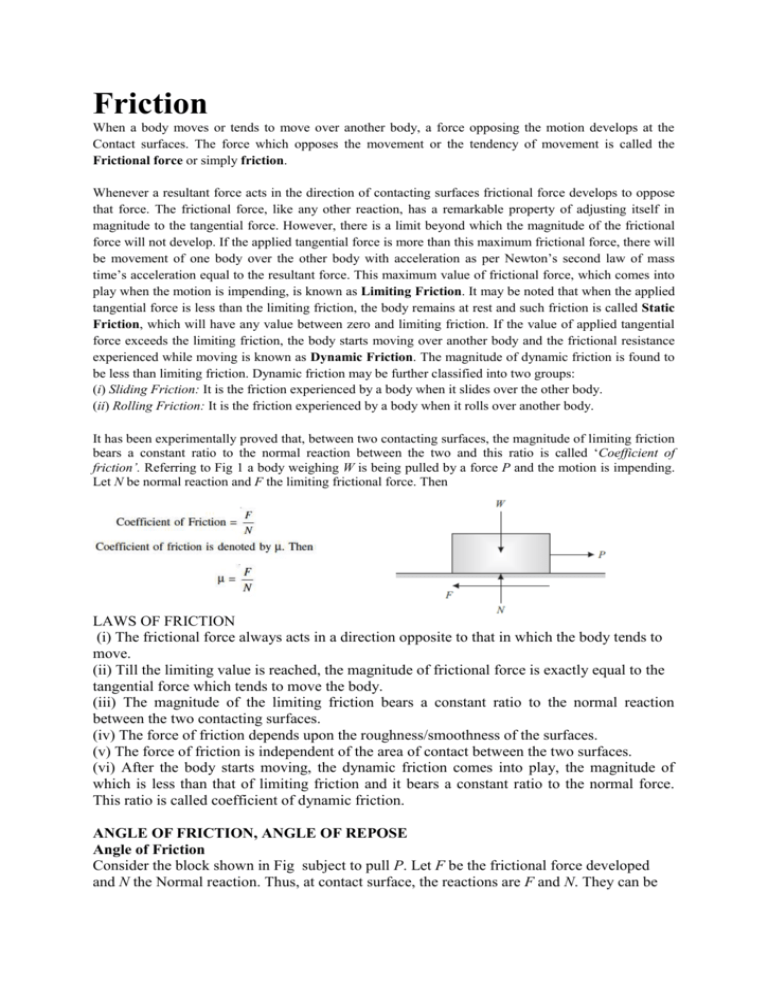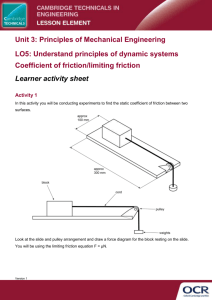Friction When a body moves or tends to move over another body, a
advertisement

Friction When a body moves or tends to move over another body, a force opposing the motion develops at the Contact surfaces. The force which opposes the movement or the tendency of movement is called the Frictional force or simply friction. Whenever a resultant force acts in the direction of contacting surfaces frictional force develops to oppose that force. The frictional force, like any other reaction, has a remarkable property of adjusting itself in magnitude to the tangential force. However, there is a limit beyond which the magnitude of the frictional force will not develop. If the applied tangential force is more than this maximum frictional force, there will be movement of one body over the other body with acceleration as per Newton’s second law of mass time’s acceleration equal to the resultant force. This maximum value of frictional force, which comes into play when the motion is impending, is known as Limiting Friction. It may be noted that when the applied tangential force is less than the limiting friction, the body remains at rest and such friction is called Static Friction, which will have any value between zero and limiting friction. If the value of applied tangential force exceeds the limiting friction, the body starts moving over another body and the frictional resistance experienced while moving is known as Dynamic Friction. The magnitude of dynamic friction is found to be less than limiting friction. Dynamic friction may be further classified into two groups: (i) Sliding Friction: It is the friction experienced by a body when it slides over the other body. (ii) Rolling Friction: It is the friction experienced by a body when it rolls over another body. It has been experimentally proved that, between two contacting surfaces, the magnitude of limiting friction bears a constant ratio to the normal reaction between the two and this ratio is called ‘Coefficient of friction’. Referring to Fig 1 a body weighing W is being pulled by a force P and the motion is impending. Let N be normal reaction and F the limiting frictional force. Then LAWS OF FRICTION (i) The frictional force always acts in a direction opposite to that in which the body tends to move. (ii) Till the limiting value is reached, the magnitude of frictional force is exactly equal to the tangential force which tends to move the body. (iii) The magnitude of the limiting friction bears a constant ratio to the normal reaction between the two contacting surfaces. (iv) The force of friction depends upon the roughness/smoothness of the surfaces. (v) The force of friction is independent of the area of contact between the two surfaces. (vi) After the body starts moving, the dynamic friction comes into play, the magnitude of which is less than that of limiting friction and it bears a constant ratio to the normal force. This ratio is called coefficient of dynamic friction. ANGLE OF FRICTION, ANGLE OF REPOSE Angle of Friction Consider the block shown in Fig subject to pull P. Let F be the frictional force developed and N the Normal reaction. Thus, at contact surface, the reactions are F and N. They can be combined to get the resultant reaction R which acts at angle θto normal reaction. This angle is given by. tanθ= As frictional force increases the angle θincreases and it can reach maximum value α when limiting value of friction is reached. Thus, when motion is impending. and this value of α is called angle of limiting friction. Hence, the angle of limiting friction can be defined as the angle between the resultant reaction and the normal to the plane on which the motion of the body is impending. Angle of Repose It is very well-known that when grains (food grains, sand, cement, soil etc.) are heaped, there exists a limit for the inclination of the heap. Beyond that the grains start rolling down. The limiting angle up to which the grains repose (sleep) is called angle of repose. Now consider the block of weight W shown in fig which is resting on an inclined plane that makes angle θwith the horizontal. When θis a small, block rests on the plane. If θis increased gradually a stage is reached at which the block starts sliding. The angle made by the plane with the horizontal is called angle of friction for the contacting surfaces. Thus, the maximum inclination of the plane on which the body, free from external forces, can repose is called angle of repose. Consider the equilibrium of the block shown in Fig. Since the surface of contact is not smooth, not only normal reaction but frictional force also develops. As the body tends to slide down, the frictional resistance will be up the plane.







